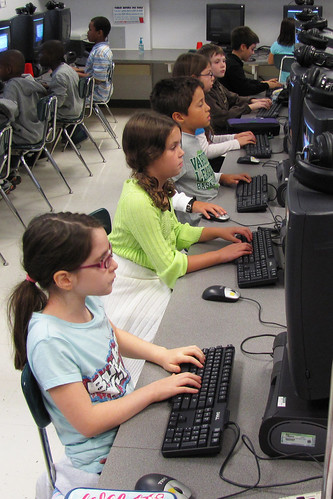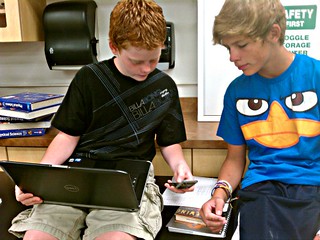Chapter 3 Transforming learning with unique, powerful technology
Focus Question: How does computer technology, promote unique, powerful, and transformative learning for students and teachers?
"Computer technologies, with their ability to make learning interesting, can promote higher levels of involvement an engagement among students..." As a teacher it is their job to obtain the students full attention, outer attention can be easily achieved by simply having class rules such remaining quiet during a lecture, staying seated, and so on. Inner attention is what needs to be achieved for true learning, having the student think and work out a problem or situation. With more and more students growing up and deeply immersing themselves in technology and communicating via the internet, it causes technology to become a gateway for teachers to use as a way to reach the students and further their learning. Teachers can create assignments, group projects, that make students think critically, problem solve, be creative, and collaborate among their peers using a platform they are already comfortable with such as social networks, social media, digital learning games, and online programs.
Photo credit to rwentechaney on Flickr
Tech Tools: Web Resources and Apps for critical thinking and problem solving
Now there is virtually a website or app for any subject learning. Students can access many different web resources or apps to help them as an extra aid in a certain subject or multiple subjects. These resources offer videos, quizzes, games, pictures, articles, and tutorials all related to what the student needs help with. Having all these different options can make it easier to boosts the students learning and understanding in different subjects.
Photo credit to marcuspage on Flickr
Summary- With all this technology such as online learning games, interactive networks, etc., it leads to promote critical thinking and problem solving among the students. It sparks curiosity, creativity, and desire for learning. Digital literacy is very important for the ability to access, understand use programs. The students have the ability to express their creative thinking through digital programs. Digital citizenship is how one treats and uses technology in our society.
Resources: Textbook - Maloy, Robert, Verock-O’Loughlin,Ruth-Ellen, Edwards, Sharon A., and Woolf, Beverly Park (2013).Transforming Learning with New Technologies. 2nd Edition. Boston, MA: Pearson Education, Inc.
Journal Post #1
Sunday, February 2, 2014
Chapter 2 Understanding Educational Technology issues and Trends
Focus Question: Analyze barriers to technology use in schools by teachers and students
Technology in the educational world is a major advancement, making teaching easier and making the learning possibilities for students endless. It is sad to say that even in this day of age that some schools do not have the sufficient funds to be able to provide the technology offered today, thus leaving them stuck in the past. Teachers with more resources have more options to different ways to engage the students learning. Lack of time could be another barrier with some teachers only having less than an hour to teach, it might be more difficult to incorporate computers in the classroom. Some older teachers that are not familiar and not taken the time properly learn might not feel comfortable incorporating into their teaching so do not use it.
Photo credit to Woodleywonderworks on Flickr
Tech tools- Apps for Teaching and learning
"There's an app for that!"-Apple. With hundreds of thousands of apps already made, there is virtually almost an app for anything. With more and more students having access to smart phones and tablets, school related apps tailored to different subjects are a great idea for studying outside of school and on the go. From personal experience, I think its a great idea to offer these types of apps. I have used this app called Quizlet, on this app you search a certain topic or subject and these pre loaded flashcards appear, you pick from a stack that applies to your studying needs. If none are related to what you need to study, you can make your own flash cards on the app, the app also comes with learning games. I have used this app in many occasions to study, I must say it has helped out greatly in many different courses.
Summary: Technology in the 21st century is all about enhancing teaching and learning techniques. Technology makes different learning platforms, it can make students interact with their assignments. Some schools may encounter barriers with technology whether it be insufficient funds to not being able to stay up to date with technology or some teachers with their own personal philosophies on teaching which might lead to them not incorporating technology in their teaching.
Resources: Textbook - Maloy, Robert, Verock-O’Loughlin,Ruth-Ellen, Edwards, Sharon A., and Woolf, Beverly Park (2013).Transforming Learning with New Technologies. 2nd Edition. Boston, MA: Pearson Education, Inc.
Focus Question: Analyze barriers to technology use in schools by teachers and students
Technology in the educational world is a major advancement, making teaching easier and making the learning possibilities for students endless. It is sad to say that even in this day of age that some schools do not have the sufficient funds to be able to provide the technology offered today, thus leaving them stuck in the past. Teachers with more resources have more options to different ways to engage the students learning. Lack of time could be another barrier with some teachers only having less than an hour to teach, it might be more difficult to incorporate computers in the classroom. Some older teachers that are not familiar and not taken the time properly learn might not feel comfortable incorporating into their teaching so do not use it.
Photo credit to Woodleywonderworks on Flickr
Tech tools- Apps for Teaching and learning
"There's an app for that!"-Apple. With hundreds of thousands of apps already made, there is virtually almost an app for anything. With more and more students having access to smart phones and tablets, school related apps tailored to different subjects are a great idea for studying outside of school and on the go. From personal experience, I think its a great idea to offer these types of apps. I have used this app called Quizlet, on this app you search a certain topic or subject and these pre loaded flashcards appear, you pick from a stack that applies to your studying needs. If none are related to what you need to study, you can make your own flash cards on the app, the app also comes with learning games. I have used this app in many occasions to study, I must say it has helped out greatly in many different courses.
Photo credit to dougbelshaw on Flickr
Resources: Textbook - Maloy, Robert, Verock-O’Loughlin,Ruth-Ellen, Edwards, Sharon A., and Woolf, Beverly Park (2013).Transforming Learning with New Technologies. 2nd Edition. Boston, MA: Pearson Education, Inc.
Sunday, January 26, 2014
Journal Post #1
Chapter 1- Becoming a 21st Century Teacher
Focus question: What role does technology play in the lives of students and teachers?
The generation of today was born into this technological advancement, which is great. As a student of this generation we definitely have had the upper hand to learning compared to students of past generations. With this technology age it brings a sense of being able to connect with the world right at your fingertips. A student can now submit their math homework, catch up on the latest events going on in the world, email their grandma, check the weather in Australia, pay a bill, and video chat right from booth at their local Starbucks. Computers have so many possibilities these days that it makes students life easier. These programs help a student anywhere from writing a paper, editing a video for a project, or even learning a new language. We even have computer programs now that can help out students that have learning disabilities. The internet is a wonderful tool as long as it is respected and used with good intentions. The internet is a information center right at your finger tips. From finding information for a project, or simply reading your local news paper online, the possibilities are endless. Social media has become a big part of the majority of us today. It lets us stay connected with family and friends, and even with new classmates and co-workers. As we go throughout life most of us go our different ways, moving to different cities, states, and even countries, but social media has given us the ability to stay in touch with old friends and family that have moved. The only downfall I think is people have developed this obsessive addiction to interacting with people via the internet or social media that they sometimes forget to interact more with people around them. I think all these technological advancements are great as long as they are used with a positive state of mind and good intentions.
Photo credit to Colorado Association of School Librarians on Flickr
Tech tools: Smart phones have evolved so much, its almost as if you are carrying a hand held computer in your pocket. I have a Samsung Galaxy Note 3 and the possibilities are almost as of a computer. With this phone I can only access the internet, make calls and send texts, but I have the ability of using Microsoft word, I can take a picture of a document and fax it, and I have the ability of printing via wireless connection with a printer. Smartphones and tablets are definitely the future of office work on the go.
Photo credit to Csaila on Flickr
Summary: Technology has been a impact on students everyday, anywhere from how they live, learn, and interact with each other. Teachers now can assign online activities done in class, online homework outside of class, and even teach a class via the internet. 21st century teacher try to incorporate all of these advancement in their teaching to enhance their students learning, resulting in the teachers digital identity.
Resources: Maloy,R.W.,Verock-‐O'Loughlin,R.,Edwards,S.A.,&Woolf,B.P.(2013).Transforminglearning with new technologies. 2nd Edition. Boston: Pearson/Allyn and Bacon.
Focus question: What role does technology play in the lives of students and teachers?
The generation of today was born into this technological advancement, which is great. As a student of this generation we definitely have had the upper hand to learning compared to students of past generations. With this technology age it brings a sense of being able to connect with the world right at your fingertips. A student can now submit their math homework, catch up on the latest events going on in the world, email their grandma, check the weather in Australia, pay a bill, and video chat right from booth at their local Starbucks. Computers have so many possibilities these days that it makes students life easier. These programs help a student anywhere from writing a paper, editing a video for a project, or even learning a new language. We even have computer programs now that can help out students that have learning disabilities. The internet is a wonderful tool as long as it is respected and used with good intentions. The internet is a information center right at your finger tips. From finding information for a project, or simply reading your local news paper online, the possibilities are endless. Social media has become a big part of the majority of us today. It lets us stay connected with family and friends, and even with new classmates and co-workers. As we go throughout life most of us go our different ways, moving to different cities, states, and even countries, but social media has given us the ability to stay in touch with old friends and family that have moved. The only downfall I think is people have developed this obsessive addiction to interacting with people via the internet or social media that they sometimes forget to interact more with people around them. I think all these technological advancements are great as long as they are used with a positive state of mind and good intentions.
Photo credit to Colorado Association of School Librarians on Flickr
Tech tools: Smart phones have evolved so much, its almost as if you are carrying a hand held computer in your pocket. I have a Samsung Galaxy Note 3 and the possibilities are almost as of a computer. With this phone I can only access the internet, make calls and send texts, but I have the ability of using Microsoft word, I can take a picture of a document and fax it, and I have the ability of printing via wireless connection with a printer. Smartphones and tablets are definitely the future of office work on the go.
Photo credit to Csaila on Flickr
Summary: Technology has been a impact on students everyday, anywhere from how they live, learn, and interact with each other. Teachers now can assign online activities done in class, online homework outside of class, and even teach a class via the internet. 21st century teacher try to incorporate all of these advancement in their teaching to enhance their students learning, resulting in the teachers digital identity.
Resources: Maloy,R.W.,Verock-‐O'Loughlin,R.,Edwards,S.A.,&Woolf,B.P.(2013).Transforminglearning with new technologies. 2nd Edition. Boston: Pearson/Allyn and Bacon.
Subscribe to:
Posts (Atom)





